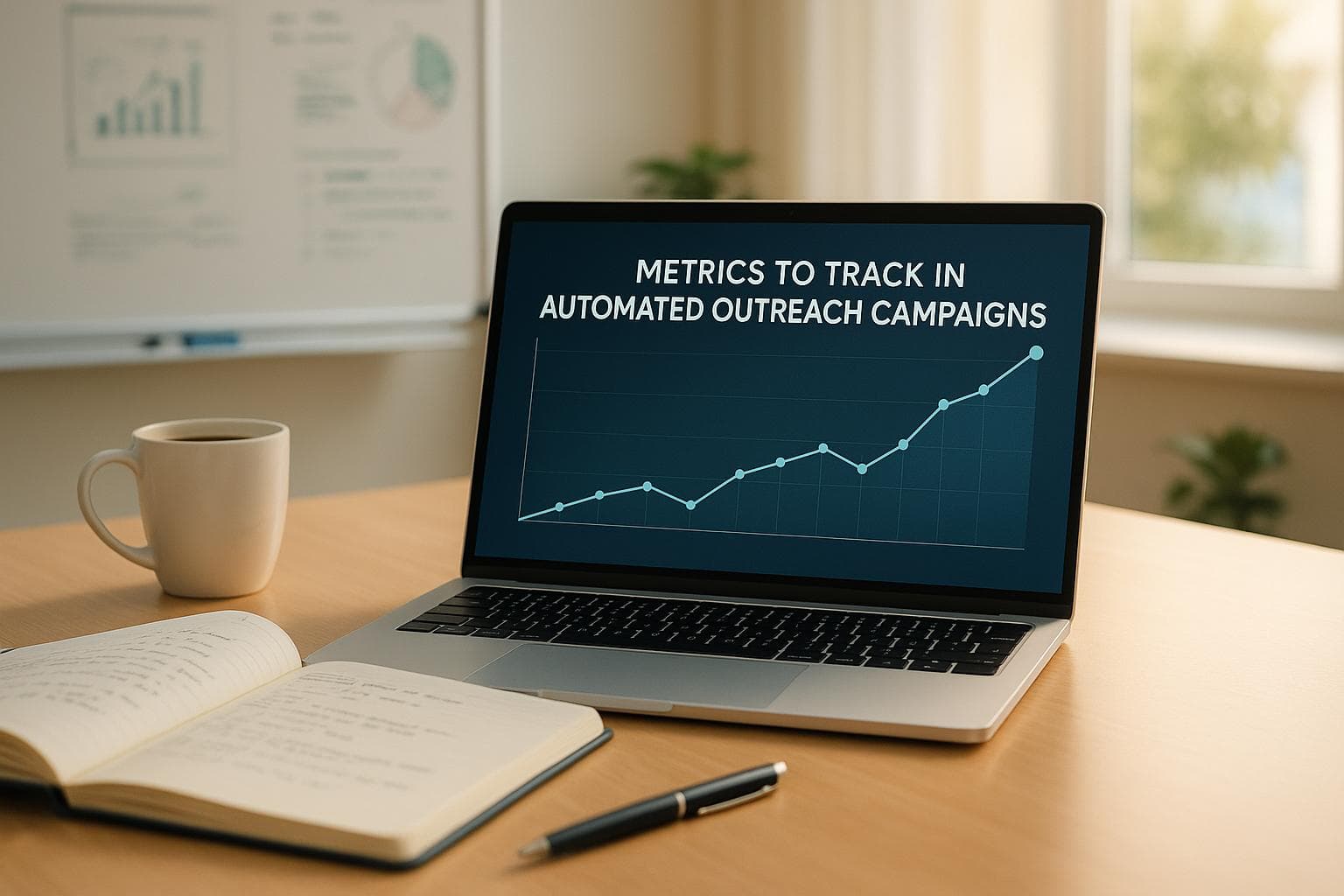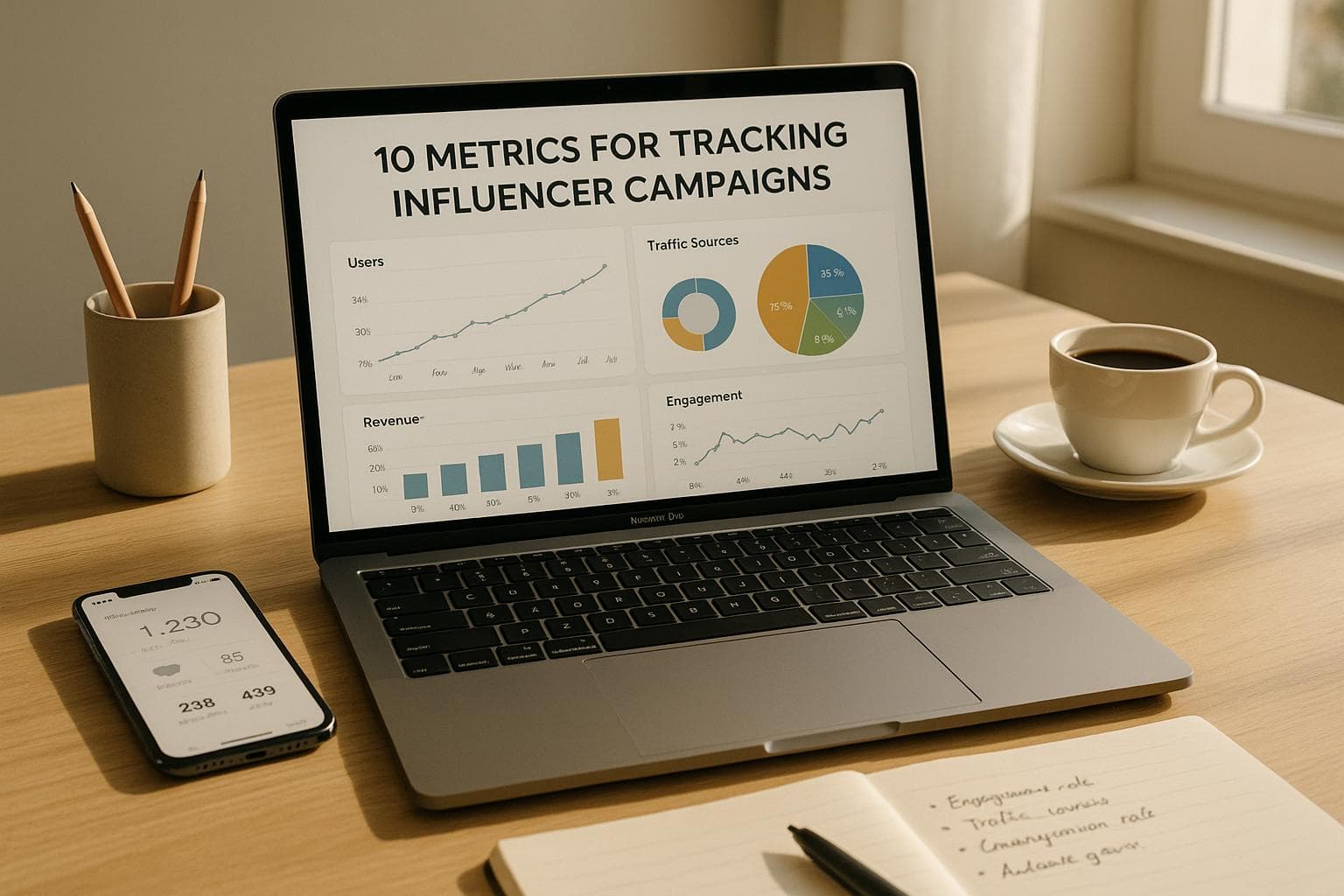Top Metrics to Track in Automated Outreach Campaigns
Explore essential metrics for optimizing automated outreach campaigns, including response rates, email performance, and audience sentiment analysis.

Automated outreach campaigns thrive on data. To succeed, you need to track and optimize these key metrics:
- Response Rate: Measures how many recipients reply. Personalization and follow-ups can boost rates significantly.
- Email Open Rate: Tracks how many people open your emails. Subject lines, timing, and mobile-friendly design are critical here.
- Meeting Conversion Rate: Shows how many outreach attempts lead to scheduled meetings. Timing, follow-ups, and tailored messaging are essential.
- Content Results: Engagement rates, content longevity, and sentiment analysis reveal how well your audience connects with your material.
- Brand Feedback Analysis: Tracks audience sentiment and feedback to improve campaigns and brand perception.
- Growth Metrics: Highlights campaign volume, efficiency, and team performance improvements through automation.
- Social Media Stats: Platform-specific engagement metrics and audience quality indicators help measure social media impact.
Quick Overview:
| Metric | What It Tracks | How to Improve |
|---|---|---|
| Response Rate | Replies to outreach | Personalization, follow-ups, timing |
| Email Open Rate | Email opens | Subject lines, timing, mobile-friendly |
| Meeting Conversion Rate | Scheduled meetings | Tailored messaging, follow-ups, timing |
| Content Results | Engagement and sentiment | UTMtracking, sentiment analysis |
| Brand Feedback Analysis | Audience reactions | Sentiment tracking, real-time monitoring |
| Growth Metrics | Campaign volume and efficiency | Automation, team performance tracking |
| Social Media Stats | Engagement across platforms | Platform-specific optimizations |
Essential Influencer Marketing KPIs to Track in 2025 (Boost ROI + Real Campaign Examples!)
1. Response Rate
The response rate is a key metric to evaluate how effective your automated outreach campaigns are. It’s calculated by taking the number of replies you receive, dividing it by the total number of messages sent, and multiplying by 100.
For context, generic cold outreach typically results in a response rate of just 1–5%. On the other hand, campaigns tailored to specific influencer tiers can produce significantly better results:
| Influencer Tier | Typical Response Rate | Notes |
|---|---|---|
| Nano (1K–10K) | 30–50% | Higher engagement since they receive fewer requests. |
| Micro (10K–100K) | 15–30% | A good mix of reach and responsiveness. |
| Macro/Mega (100K+) | 5–15% | Lower rates due to the sheer volume of pitches they get. |
To improve your response rates further, focus on timing and personalization in your outreach efforts:
Message Timing and Follow-ups
Sending messages during peak hours and following up strategically can make a big difference. For example, send your first follow-up 3–5 days after the initial message, and a second one 5–7 days later. These follow-ups can boost your response rate by 25–35%.
The Power of Personalization
Generic templates rarely work. Instead, craft personalized messages that mention specific content or details about the recipient. This approach can double your response rate.
By leveraging tools like Influs analytics, you can go even further. These tools help you identify the best-performing templates, determine the ideal timing for each influencer tier, and analyze both the sentiment and quality of responses. With this data, you can continuously refine your outreach strategy for better results.
2. Email Open Rate
After understanding response rates, the next step is to gauge how much attention your outreach grabs through email open rates.
The email open rate measures the initial effectiveness of your campaign. It’s calculated using the formula: (Opens ÷ Emails Sent) × 100.
Typical open rates hover between 15–25%. Campaigns targeting micro-influencers often achieve higher rates, around 25–35%, while outreach to celebrities generally sees lower engagement.
Key Factors That Influence Open Rates
Subject Line Effectiveness: The subject line is your first impression. Personalized subject lines, like including the influencer's name or referencing their recent work, can increase open rates by as much as 26% compared to generic ones. Aim to keep subject lines under 40 characters so they’re easy to read on mobile.
Timing Matters: Emails sent mid-week (Tuesday to Thursday) typically perform better than those sent on Mondays or Fridays. Leveraging tools like Influs's analytics can help you pinpoint the best times to reach your specific audience.
Mobile-Friendly Design: Since 60% of influencers check emails on their phones first, ensure your email design is responsive and easy to read on smaller screens. Keep text concise and avoid clutter.
Strategies for Testing and Improving Open Rates
To enhance open rates, adopt a structured A/B testing approach. Test one variable at a time for clearer insights:
- Subject Line Variations: Try different levels of personalization, lengths, or formats (e.g., questions versus statements).
- Sender Name: Compare emails sent from your company name versus a personal name to see which feels more approachable.
- Send Timing: Experiment with various days and times based on when your influencers are most active.
When analyzing open rate data, don’t stop at the overall percentage. Dig deeper to uncover trends by segmenting your results - look at performance across different influencer groups, subject line styles, send times, and campaign types. This detailed view can reveal what’s working and where adjustments are needed.
Use Influs’s real-time analytics to monitor these changes and refine your outreach strategy. When combined with response and conversion rates, open rates provide a fuller picture of how well your campaign is performing.
3. Meeting Conversion Rate
After tracking email open rates, the next critical metric to focus on is meeting conversion rates. This measures how successfully your outreach efforts lead to scheduled meetings. Just like open and response rates, understanding this metric is key to fine-tuning your automated outreach strategy.
What Is a Meeting Conversion Rate?
The meeting conversion rate tells you how many of your outreach attempts result in scheduled meetings. Here’s the formula:
(Number of Meetings Scheduled ÷ Total Outreach Attempts) × 100
For example, if you contact 200 influencers and manage to schedule 30 meetings, your conversion rate would be 15%. Generally, well-targeted and personalized campaigns see rates ranging from 10% to 25%.
Factors That Influence Meeting Conversions
Several elements play a role in boosting meeting conversions:
- Timing: Reaching out at the right moment can make all the difference.
- Follow-ups: Consistent follow-ups keep the conversation alive and increase chances of scheduling.
- Tailored Messaging: Personalizing your outreach makes it more relevant and engaging.
Platforms like Influs can assist by offering insights into the best times to follow up, based on influencer engagement habits.
Tips to Boost Your Meeting Conversion Rate
Here are a few strategies to help you secure more meetings:
- Use automation tools while adding a personal touch with AI-driven insights.
- Group influencers into segments based on factors like audience size, content type, or past interactions.
- Simplify scheduling by offering multiple time slots, providing clear agendas, and integrating automated calendar tools.
Keep an Eye on Your Metrics
Use analytics dashboards to track your meeting conversion rate and pinpoint what’s working. By identifying patterns and refining your approach, you can steadily increase your success rate over time.
4. Content Results
Keeping tabs on content performance is crucial to understanding how well your audience connects with your material. By analyzing metrics ranging from basic engagement to deeper qualitative feedback, you can refine your strategies for future campaigns.
Key Engagement Metrics
A solid starting point is calculating your engagement rate:
Engagement Rate = (Engagements ÷ Total Reach) × 100
Different platforms have their own typical engagement benchmarks:
| Platform | Average Engagement Rate |
|---|---|
| 1–3% | |
| TikTok | 3–9% |
| YouTube | 1–5% |
These numbers offer a baseline to compare your performance and identify areas for improvement.
Advanced Performance Tracking
Going beyond basic metrics, dig into these advanced areas:
- Content Longevity: Look at engagement over time. Track immediate responses in the first 24 hours and compare them to longer-term patterns over 30 or 90 days. This helps you understand how long your content stays relevant.
- Format Performance: Evaluate how different formats perform. For instance, videos tend to drive about 38% more engagement than static images. Compare results across stories, posts, videos, and carousels to see what resonates most with your audience.
Measuring Content Impact
To understand how your content drives actions, use tools like UTM parameters on your links. This allows you to track:
- Website traffic from specific campaigns
- Time users spend on your site
- Pages viewed per session
- Conversion activities, like sign-ups or purchases
Adding personalized elements to your content can increase engagement rates by up to 74%. Beyond the numbers, it’s also important to get a feel for how your audience perceives your content.
Sentiment Analysis
Dive into the emotional response your content generates by tracking:
- The balance of positive vs. negative comments
- Patterns in audience feedback
- The context of brand mentions
- The overall tone and quality of the feedback you receive
This qualitative data can be just as valuable as hard numbers when shaping your strategy.
Content Amplification
Finally, measure how far your content reaches beyond your immediate audience. Key indicators include:
- Shares and reposts
- User-generated content volume
- Hashtag activity
- Frequency of brand mentions
sbb-itb-0e1095d
5. Brand Feedback Analysis
Analyzing brand feedback helps you understand how audiences perceive your influencer partnerships. These insights go hand-in-hand with other performance data, allowing you to fine-tune strategies on the fly.
Sentiment Tracking Metrics
To gauge audience sentiment, focus on these key metrics:
| Metric Type | What to Track | Purpose |
|---|---|---|
| Direct Feedback | Comments, DMs, mentions | Capture immediate audience reactions |
| Engagement Quality | Reply tone, emoji usage | Understand emotional responses |
| Brand Mentions | Volume, context, timing | Track brand visibility |
| Response Patterns | Common themes, questions | Spot areas needing improvement |
Automated Sentiment Analysis
AI tools like Influs make it easier to gather and analyze feedback. They quickly identify trends and flag potential issues, saving time and providing actionable insights.
"Brands that actively monitor and respond to social media feedback see up to a 25% increase in positive brand sentiment and a 15% reduction in negative mentions over a six-month period".
Turning Feedback Into Action
Here’s how you can use feedback effectively:
- Comment Context Analysis: Look at both the number and quality of comments to understand audience reactions.
- Response Time Monitoring: Evaluate how quickly your team engages with audience inquiries.
- Sentiment Trend Tracking: Keep an eye on shifts in sentiment to identify what’s working in your campaigns.
Benefits of Real-Time Monitoring
Using real-time analytics tools provides several advantages:
- Quickly address issues before they escalate.
- Build on positive momentum during active campaigns.
- Adapt messaging based on immediate audience feedback.
- Track sentiment changes across various influencer partnerships.
Measuring the Impact of Feedback
To understand how well your feedback analysis is working, monitor these metrics:
- The ratio of positive to negative comments.
- Shifts in sentiment around brand mentions.
- Response times to audience questions.
- Engagement levels on follow-up content.
This data not only highlights your return on investment (ROI) but also helps refine your overall strategy. Interestingly, 16% of marketers now rank sentiment analysis as a top metric for evaluating marketing automation performance.
Advanced Analysis Techniques
Take your feedback analysis to the next level with these methods:
- Theme Categorization: Group audience feedback into categories to spot recurring patterns.
- Cross-Channel Analysis: Compare sentiment trends across different platforms.
- Influencer Impact Assessment: Evaluate how influencer collaborations impact your brand’s perception.
6. Growth Metrics
Growth metrics provide a clear picture of how automation transforms outreach efforts. They don't just measure the volume of campaigns but also highlight improvements in team efficiency and overall performance.
Campaign Volume and Efficiency
Automation dramatically increases the scale of outreach. Here's a snapshot of how it impacts campaign management:
| Metric | Before Automation | With Automation | Change |
|---|---|---|---|
| Active Campaigns | 2–3 per month | 8–15 per month | +300–400% |
| Setup Time | 8–12 hours | 2–4 hours | –75% |
| Team Resources | 3–5 members | 1–2 members | –60% |
Team Performance Indicators
Automated campaigns bring measurable improvements in team performance. Some key highlights include:
- Teams cut setup time by 40–60%
- Each team member handles 3–4x more prospect responses
- Consistency scores exceed 90% during scaling
- Resource utilization rates hover between 70–80%
Scaling Intelligence
Growth metrics don't just show results - they guide strategy. For example, companies leveraging marketing automation see a 451% increase in qualified leads while lowering marketing costs by 12.2%. These numbers underscore the importance of using metrics to fine-tune campaigns and maximize returns.
Capacity Management
Scaling outreach is exciting, but it requires careful monitoring to maintain quality. Key areas to watch include:
- Team response capacity to ensure timely follow-ups
- Personalization accuracy to maintain relevance
- System performance to avoid downtime
- Campaign launch timing to optimize impact
Advanced Growth Tracking
Top-performing marketing teams zero in on specific metrics to ensure sustainable growth. These include:
- Campaign-to-staff ratio: Keep it at an optimal 3–5 active campaigns per team member
- Channel synergy: Measure how well channels work together
- Setup optimization: Continuously refine processes to reduce setup time
7. Social Media Stats
Keeping an eye on social media metrics is essential for understanding how well your outreach efforts are performing. Each platform has its own set of metrics that require tailored attention.
Platform-Specific Performance Metrics
Different social media platforms rely on unique engagement indicators to measure success:
| Platform | Key Metrics | Strong Performance |
|---|---|---|
| Engagement Rate (likes + comments + saves ÷ followers) | 3–6% | |
| TikTok | Video Completion Rate (views ÷ total impressions) | 5–10% |
| Professional Engagement (interactions + clicks ÷ impressions) | 2%+ | |
| Twitter/X | Interaction Rate (likes + retweets + replies ÷ impressions) | 1–3% |
While these metrics provide a good starting point, it's equally important to assess the quality of your audience to gain deeper insights into your campaign's success.
Audience Quality Indicators
To complement platform-specific metrics, consider these indicators to evaluate the value of your audience:
- Follower Growth Rate: Measure the percentage increase in followers during your campaign.
- Retention Rate: Assess how many followers stick around 30–60 days after the campaign ends.
- Demographic Alignment: Check how closely new followers align with your target audience.
- Content Affinity: Identify which themes or types of content resonate most with your audience.
Advanced Engagement Analysis
Social media metrics go beyond basic likes and shares. Dive deeper with these advanced indicators:
- Content Saves: Monitor how often users save or bookmark your content for later.
- Second-Degree Engagement: Track interactions from users who aren’t directly following you.
- Cross-Platform Impact: Analyze overlap in audience behavior across multiple platforms.
- Community Contribution: Evaluate the volume and quality of user-generated content associated with your brand.
Sentiment Tracking
Tracking sentiment helps you understand not just how much people engage, but how they feel about your content. Look for thoughtful comments and authentic user-generated content that reflect positive sentiment and deeper connections with your audience.
ROI Measurement
To measure the return on investment (ROI) for your campaigns, use this formula:
ROI = [(Revenue – Campaign Cost) ÷ Campaign Cost] × 100
For awareness campaigns, estimate $5–$10 per 1,000 impressions and aim for an ROI of 3–5×. Pairing ROI with engagement metrics ensures your strategy remains focused on both data and audience impact.
Real-Time Monitoring
Leverage automated tools to track metrics across platforms in real time. These tools can help you monitor daily engagement trends, content performance, audience growth, response times, and the overall pace of your campaigns. Quick adjustments based on real-time data can make a big difference in your campaign’s effectiveness.
Manual vs. Automated Results
When planning your outreach strategy, understanding the differences between manual and automated methods can help you find the right balance between scale and quality. These metrics will guide you in fine-tuning your approach to achieve the best return on investment (ROI).
Volume vs. Quality Trade-off
Automated outreach wins in sheer numbers, reaching 5–10 times more contacts than manual efforts. However, it often sacrifices engagement quality for volume. Here's a side-by-side comparison:
| Metric | Manual Outreach | Automated Outreach |
|---|---|---|
| Open Rate | 25–30% | 15–20% |
| Response Rate | 15–20% | 5–8% |
| Daily Contact Capacity | 50–100 | 500–1,000 |
| Cost per Contact | $5–15 | $0.50–2 |
Conversion and Personalization Impact
Manual outreach excels in personalization, often generating responses that are 30–40% more meaningful. Automated systems, however, are narrowing this gap with dynamic content, achieving 5–10% improvements in personalization. Notably, automated outreach often leads to 15–25% higher average deal values and sales cycles that are 20–30% shorter. This makes it a valuable option for campaigns prioritizing efficiency.
Cost-Effectiveness Assessment
For campaigns targeting over 500–1,000 contacts, automation is the more cost-effective choice. However, when dealing with high-value prospects - those with potential deals exceeding $10,000 - the higher costs of manual outreach can be justified by the superior engagement quality.
Time Investment and Resource Allocation
Automated campaigns require only hours to set up, compared to weeks for manual outreach. Follow-up completion rates also highlight the efficiency of automation, with 95–98% completion compared to 60–70% for manual efforts. This allows automated strategies to scale exponentially, while manual methods grow more linearly.
Hybrid Approach Performance
A hybrid strategy, combining both manual and automated methods, often delivers the best results. Organizations using this approach report conversion rates that are 15–20% higher than purely automated campaigns, while still retaining 70–80% of the efficiency benefits. This blend maximizes both quality and scale.
Follow-up Effectiveness
Manual follow-ups tend to achieve response rates that are up to 30% higher than automated ones. However, automated sequences ensure a completion rate of 95–98%. An optimal strategy might include 3–5 manual touchpoints paired with 6–8 automated follow-ups over a period of 3–7 days. This mix ensures both persistence and personalization.
Measuring Campaign Success
To evaluate the success of your outreach campaigns, focus on these key metrics:
- Total positive responses
- Efficiency of resource use
- Time to complete the campaign
- Quality of converted leads
- Overall ROI
While automated outreach often shows lower engagement rates, its volume advantage can result in more total conversions. Choosing the right approach depends on your campaign goals and the value of your target audience. By aligning your strategy with these factors, you can maximize both efficiency and effectiveness.
Conclusion
Running effective automated outreach campaigns hinges on keeping a close eye on key performance metrics and fine-tuning them as needed. To get the most out of your outreach efforts, prioritize these critical areas:
- Engagement Metrics: Keep tabs on open rates and response rates to understand how well your initial outreach is resonating.
- Conversion Metrics: Look at meeting bookings and content interactions to measure how successful your campaign is at driving action.
- Growth Indicators: Pay attention to follower growth and lead generation to assess long-term impact.
- Brand Sentiment: Collect qualitative feedback and social proof to gauge how your audience feels about your brand.
These metrics are the foundation of any outreach strategy that aims to deliver measurable results. Using AI-driven tools can take this a step further by turning raw data into actionable insights.
For example, tools like Influs provide real-time analytics and advanced tracking capabilities. One brand using Influs revamped their subject lines and targeting approach, which resulted in a 25% jump in open rates and a 15% rise in meeting conversions.
To achieve the best results, combine the efficiency of automation with the personal touch of manual effort. This balance not only saves time but also ensures your outreach feels authentic and tailored.
FAQs
What are the best ways to personalize automated outreach messages to boost response rates?
Personalizing automated outreach messages can significantly boost engagement and response rates. A good starting point is using the recipient's name and referencing specific details about their work, interests, or recent accomplishments. This shows that your message isn’t just another copy-paste job but something crafted with them in mind.
Another effective strategy is segmentation. Group your audience based on shared traits like industry, location, or demographics, and then create messages that speak directly to each group’s needs or interests. This targeted approach helps your outreach feel more relevant.
Finally, keep your tone natural and conversational. Avoid sounding like a robot or using overly generic language. Small adjustments like these make your messages feel more genuine and relatable, which can go a long way in encouraging positive responses.
How can I optimize the timing of my outreach emails to improve open and conversion rates?
Timing plays a key role in making automated outreach campaigns more effective. To get the best engagement and conversion rates, it's important to focus on when your emails land in your audience's inbox. Here's how you can improve your timing:
- Study your audience's habits: Dive into your data to understand when your target audience is most active online. For instance, weekdays in the morning or early afternoon often see higher engagement.
- Test different schedules: Use A/B testing to try out various days and times. This helps you pinpoint when your audience is most likely to respond.
- Consider time zones: If you're reaching out to people in different regions, schedule your emails to arrive at the ideal time for each recipient's local timezone.
Adjusting your email timing with these steps can make a noticeable difference in your campaign's success and return on investment.
How can I evaluate the success of my outreach campaigns in shaping brand perception and audience sentiment?
To assess how your outreach campaigns are shaping brand perception and audience sentiment, keep an eye on important metrics like engagement rates, audience feedback, and sentiment analysis. Look at comments, shares, and direct messages to get a sense of how people are emotionally reacting to your efforts.
Tools like social listening can also be incredibly helpful. They let you track brand mentions and evaluate the tone of discussions surrounding your brand. By combining these insights with real-time analytics and in-depth reports, you can get a clearer picture of how your campaigns are impacting public opinion. This approach also helps fine-tune future strategies for even better outcomes.
Related posts
- Guide to Instagram Analytics for Influencer Selection
- How to Calculate Influencer Engagement Rates
- Top 7 Influencer Dashboard Metrics to Track
- 10 Metrics for Tracking Influencer Campaigns
Related Posts
Continue reading with these related articles


